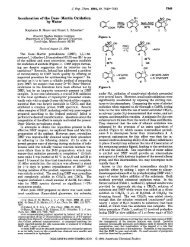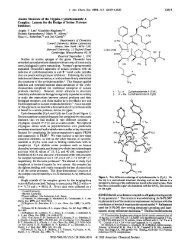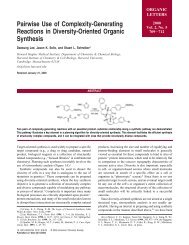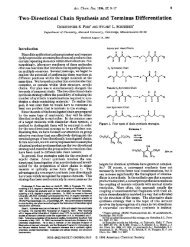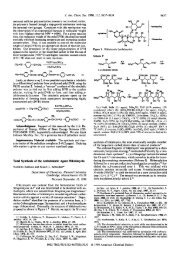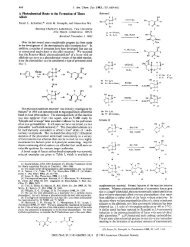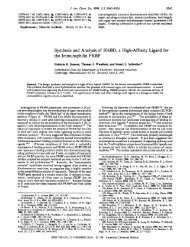Download - American Chemical Society Publications
Download - American Chemical Society Publications
Download - American Chemical Society Publications
You also want an ePaper? Increase the reach of your titles
YUMPU automatically turns print PDFs into web optimized ePapers that Google loves.
ARTICLES<br />
Lo et al.<br />
Figure 4. (a) 1 H NMR of the crude product from one macrobead. The bold arrows indicate signals corresponding to the product. The regular arrows<br />
indicate signals corresponding to the deprotected intermediate. (PhMe 2Si) 2O was used as an internal standard for determining the loading level. (b) LC/MS<br />
of the corresponding sample. One peak was shown in the UV trace, but the peak actually consists of the product (MW ) 745) and the deprotected intermediate<br />
(MW ) 715). There was a 0.6 min shift between the UV trace and the MS trace.<br />
Dolle has reported a similar approach to the same problem. 41<br />
The sample was recorded “pure” if the UV trace at λ ) 254<br />
nm suggests a purity better than 80%, and the predominant<br />
compound has a molecular mass that matches one of the possible<br />
combinations. Within a sample of size n, the number of pure<br />
samples should follow a hypergeometric distribution, which can<br />
be approximated by a binomial distribution. 42 The confidence<br />
intervals for the population purity p can be readily determined<br />
from the number of pure samples and the sample size. 43 Since<br />
we are interested only in the lower limit, the one-sided lower<br />
limit at the 95% confidence interval is determined by setting R<br />
) 0.10.<br />
Figure 5 shows the purity analysis of the samples. Since the<br />
pools that are in parallel (C3/D0, C3/D1, C12/D0, C12/D1)<br />
are expected to contribute only about one-tenth of the number<br />
of compounds from the main pools, we normalized them so<br />
that each of these pools contributes only one datum point. Hence<br />
the total number of samples analyzed was 44, and the adjusted<br />
number of pure compounds was between 40 and 41. 44 The lower<br />
limit of purity for the whole library thus calculated is approximately<br />
82% (one-sided 95% confidence interval), satisfying<br />
our target figure of 80%. 45<br />
(41) Dolle, R. E.; Guo, J.; O’Brien, L.; Jin, Y.; Piznik, M.; Bowman, K. J.; Li,<br />
W.; Egan, W. J.; Cavallaro, C. L.; Roughton, A. L.; Zhao, Q.; Reader, J.<br />
C.; Orlowski, M.; Jacob-Samuel, B.; DiIanni Carroll, C. J. Comb. Chem.<br />
2000, 716-731.<br />
(42) The multiplicative finite population correction factor for the confidence<br />
limit is given as ((N - n)/(N - 1)), where N is the number of beads in<br />
the whole library and n is the number of beads in the sample. The factor<br />
is greater than 0.99 and hence approximated by 1.<br />
(43) Intercooled Stata 8.0 for Macintosh; Stata Corporation: College Station,<br />
TX, 2003.<br />
As the final step prior to moving library members to a<br />
collection maintained at the screening center sponsored by the<br />
Initiative for <strong>Chemical</strong> Genetics (ICG), the macrobeads were<br />
arrayed into 384-well plates. Compounds were cleaved with<br />
HF•pyridine and eluted from the solid phase in an automated<br />
fashion, a process referred to as formatting. 3b Altogether 20 plates<br />
of compounds were formatted. A final quality control was<br />
performed with the formatted compounds, which revealed that<br />
the purity of the library was lowered. This observation was<br />
expected, since the formatting process involves a number of<br />
automated liquid-handling steps and solution transfers. Using<br />
a less stringent criterion, 45 out of 59 wells had purity better<br />
than 70% and were recorded as pure. The lower limit of purity<br />
thus determined was 65%. By removing the plate that contains<br />
the building block combination C3/D1, we improved the lower<br />
limit to 70%. The remaining 19 plates of library compounds<br />
are now stored as part of the ICG DOS collection, available for<br />
screening by the scientific community. 46 The library was also<br />
printed on glass slides, enabling its use in small-molecule<br />
microarray assays. 47<br />
(44) For pools C3/D0, C3/D1, C12/D0, and C12/D1, the number of pure<br />
compounds coming out from each of them can have a value of either 0 or<br />
1. Based on the analysis on the macrobeads from these pools, we assign a<br />
value of 1 for C3/D0 (p 1 ) 0.875), a value of 0 for C3/D1 (p 2 ) 0), and<br />
a value of 1 for C12/D0 (p 3 ) 1.0). Since pool C12/D1 gives a p 4 value<br />
of 0.6, we cannot assign a definite value of either 0 or 1. We therefore<br />
report the total number of pure compounds as a range and calculate the<br />
lower limit in each case.<br />
(45) The average of the two lower limits from 40 pure compounds (80.4%) and<br />
41 pure compounds (83.3%).<br />
(46) For a listing of libraries available for screening at the ICG, see http://<br />
iccb.med.harvard.edu/chemistry/compound_libraries/libraries_available.htm<br />
(accessed August 2004).<br />
16084 J. AM. CHEM. SOC. 9 VOL. 126, NO. 49, 2004



